Lecture
Introduction
In this paper, an attempt will be made to describe the model of artificial intelligence. A new way of organizing neural networks will be presented here. It will be described what a sensation is, a representation, how and when neurons connect, why neurons excite and inhibit each other, how induction and deduction are realized in neurons, how reasoning occurs. This problem cannot be solved partially, it needs to be covered entirely, then everything will be in its place.
The model presented here is not based on the perceptron proposed by Rosenblatt. Yes, the model is beautiful! Recognizes images and the more layers, the better it does. All you have to do is place the weights between the connections of the neurons. And everything is fine! But the question arises, which organ in the body specializes in this? What is this mathematical accuracy? And it is not clear why the development of artificial intelligence went this way. Therefore, in this work a new approach to this problem is proposed.
This work only describes how artificial intelligence works; to create it is really very difficult. Science is not ready yet for this. So far, people are only studying the properties of cells, and modifying existing ones, but who have not yet managed to create a cell with only a set of chemical elements.
What is known to science today.
Let's see what science has in this area today:
There is an element neuron;
The structure of the neuron is known (axon, dendrite, membrane, etc.);
It is known that neurons in the process of cognition of the surrounding world are overgrown with connections between themselves;
Neurons are not the same, but are subdivided (sensory, motor, etc.);
The process of excitation and inhibition of neurons is known;
Chemical processes occurring in the neuron during inhibition and excitation are known;
After excitation of a neuron, it is restored for a while.
Let us dwell on the mechanism of neuron excitation. When activated, the neuron sends an electrochemical signal along its axon. Through the synapses, this signal reaches other neurons, which can in turn be activated. A neuron is activated when the total level of signals coming from the dendrites to it exceeds a certain level (activation threshold). Each synapse has a length and special chemicals that transmit a signal along it. Neurons can mutually activate and inhibit each other.
Let's see what science is known logic about thinking. It says that the process of knowledge begins with sensations. Sensations are a reflection of individual properties of objects and phenomena of the world. Perception is created on the basis of sensations, where objects and phenomena are reflected as a whole. When we remember about any objects or phenomena in our memory there are images of previously perceived objects. These images are called representations. On the basis of sensations, perceptions and ideas, signs of objects or phenomena are formed. Transferring a sign of one object or phenomenon to another is called thinking. The main elements of thinking are deduction and induction.
Then you can not go deep, for understanding the basic principles of artificial intelligence is enough, the main thing is to combine all and see the situation as a whole.
How the sensation, perception, representation in neurons is reflected.
To understand this, turn to everyday life. Consider the situation of dental treatment in the dental office. Suppose the patient has pulpitis. Whatever he feels pain, he is given local anesthesia (using novocaine or something else). What's happening? The person stops feeling pain, the sensitive neurons that react to pain are blocked. It can be concluded that sensation is the excitation of sensitive neurons. Another example: a person has been sick since birth with anosmia - the absence of smell, such a person, however much we want, cannot explain what an orange or flower smell is. For a person without pathologies, for example, a sweet is an excited group of sweet reacting receptors. The same with other phenomena, blue is the excitement of a certain group of sensitive neurons excited by blue, itching is the excited receptors of the skin. Consider now what is perception. Let it be, the perception of snow by man. Highlight its main features: cold, white. We give it to the man. What will happen? In humans, sensitive neurons that react to cold and white color will be excited. This is how the perception of snow originated in two groups of neurons. It turns out that a living being, in particular a person, is a set of multiple groups of neurons, where each group reacts to a specific stimulus and carries a peculiar feeling. Speech, pain, sight, smell, hearing - this is all the excitement of a particular group of neurons. Now consider what a presentation. Take the same example with snow. For our man, the idea of snow is an excited group of sensitive neurons reacting to the cold and white in its absence. How this is implemented using neurons will be indicated below, after describing the connection of neurons.
Why these feelings are not clear in neurons, but the description of many diseases (Anosmia, Achromatopsia, etc.), and much more indicates that this is so. This should be treated in the same way as we treat electricity, magnetism, atoms, as the basis of the world. This is some unknown matter or something else. Most likely, feelings can be combined into a table similar to the periodic table, but this is not the purpose of this work.
It is not a shame, but real artificial intelligence cannot be implemented on today's computer, feelings are needed here, but they are not in a computer, and the computer architecture is not very suitable for this. Although without much effort you can simulate on a computer or create electronic artificial intelligence, its behavior resembling a real one, but in reality it will be insensitive.
The connection of neurons.
Let us see how groups of neurons in the process of vital activity will connect with each other. To do this, turn to the school course of biology and recall the experience of Pavlov with the dog. How did Pavlov develop reflexes? Before feeding the bell sounded, and after the food was given. When the bell sounded and food was not given, the dog showed increased salivation. She was involved in the processing of neurons responsible for the processing of food, although there was no food. A reflex was developed. So, somehow the neurons that react to the sound, began to excite the neurons responsible for digestion. Here the first thing that comes to mind is that the axons and dendrites of these neurons are connected. From this we can assume that neurons, after their excitation, are connected to each other. And it is not necessary to calculate the weights of these relations, somehow they connected well and well. What the axon connected with the dendrite, the dendrite with the dendrite is not important, the main connection (Fig. 1).
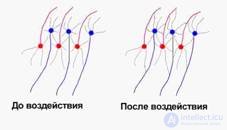
Pic.1
And one cannot but agree with Pavlov that the thinking of a person is reflexes. Just add feelings to it. Consider this experience from the science of logic. What is Pavlov's dog food? This is the excitation of groups of neurons: taste receptors, some groups of receptors of sight and smell, neurons reacting to the sound of a bell. What follows after not giving food to a specially trained dog? Groups of neurons responsive to sound begin to excite groups of neurons of taste, vision, and all other groups that are associated with it. Here it is a presentation! The dog has aroused groups of neurons reacting to food, in its absence.
This is also confirmed by the experience of two groups of rats. Some were protected from all sorts of irritants, while others were “tortured” with irritants: they turned on the light, forced them to look for food, etc. After analyzing their brains, it was found that in rats of the first group of connections between neurons was much less than in rats of the second group.
Sequence of thinking
In many articles on artificial intelligence, it is assumed that a person thinks in parallel. But in the artificial intelligence model presented here, it will be assumed that the thinking is consistent. It is supposed that groups of sensitive neurons of pain, taste and other blocks cannot be simultaneously excited, that their excitement alternately replaces each other. This assumption is made from observations and from the created model of artificial intelligence. Parallel scheme of thinking does not work. It turns out some kind of convulsive intelligence. Although it may be, whoever will be able to simulate a parallel scheme. The fact that thinking is consistent also indicates the following observation: if a person is given a sweet candy, and after a slice of black pepper, the person will feel only bitterness, he will have no time for candy, he will forget about it. The neurons responsible for the taste of bitter will block the neurons responsible for the taste of sweet.
Ladder priorities. Mutual inhibition of groups of neurons.
Let's try to create the simplest artificial intelligence. To do this, create a simple beetle. First, we define what our bug should pay attention to in the world around us in order to survive. The most important thing, of course, is self-preservation, so the block of pain neurons should have the highest priority (Priority-1). When it is excited, all other blocks should be blocked. Next, of course the need for nutrition (Priority-2). In order for a bug to enjoy life, we’ll add a block of pleasure (Priority 3), in real organisms it can be neurons that react to sweets. Let us give him a sense of smell, let him distinguish between two smells (Priority-4). Let him see, distinguish three colors green, red, blue (Priority-5). For the simplest model, this is sufficient. Now combine all these blocks of neurons into a circuit and call it the ladder of priorities (Fig. 2).
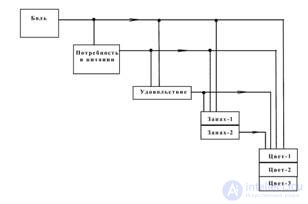
Pic2
The lines between blocks are inhibitory connections between blocks of neurons. The Odor-1 block blocks the Odor-2 block; they are combined together for clarity in the diagram. From fig. 2 that when the Scent-1 and Pain block is simultaneously excited, the Pain Block will block the Scent-1 block. Also with other blocks. For normal operation of the circuit, the inhibitory neurotransmitters must have the following properties: they decay very quickly and they must be constantly released when a block is activated. Otherwise, the scheme will be in the stopper, it will not work until the inhibitory neurotransmitters disintegrate. Looking ahead, it should be said that almost all excitatory neurotransmitters should have opposite properties: stand out in portions, slowly decay to excitement and quickly disintegrate after excitation, but neurotransmitters with the same properties as inhibitory neurotransmitters are also needed.
There is a flaw in this scheme. With a weak pain and strong odor-1, the block of Pain will be excited, which is a little acceptable for the survival of the organism. Therefore, this scheme must be supplemented. A more complex and detailed priority ladder diagram with reverse blocking is shown in fig. 3, for ease of perception, it consists of three sensitive units. A larger number of blocks is connected according to the same principle.
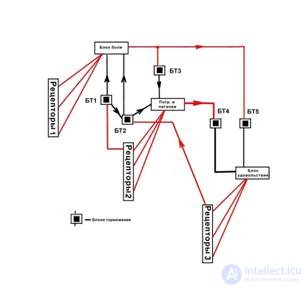
Fig. 3
For the operation of the circuit, it is important to choose the threshold of excitation of neuron blocks. Braking blocks BT1, BT2, BT4 should have a high excitation threshold. They should be activated only if a large number of corresponding receptors are activated. Blocks BT3, BT5 must always be activated when their sensitive unit is activated (there must be a low excitation threshold). Consider the main options that may arise during the operation of the scheme.
All receptors are very excited. Excited: block pain, BT1, BT2. The BT1 block will block the BT2 block and attempt to block the Pain block. But since the receptors are highly excited, the inhibitory connections of the BT1 block are not enough to block the Pain block. As a result, the Pain unit will be activated.
Receptors 2 and 3 receptors are highly excited, and receptors 1 are weak. The BT1 block will block the BT2 and the Pain block. The Food Requirements block is activated.
Receptors 3 are highly excited, and receptors 1 and receptors 2 are weak. The BT2 block will block the Pain block and the Nutrition block. The Pleasure block is activated.
There are more options, but in any case, a block will always be excited, in which the receptors are more excited, and if several groups of receptors are strongly excited, a sensitive block will be excited, whose priority is higher.
The complete scheme of the simplest artificial intelligence and a description of his thinking.
We endow our beetle with a Grabbing Food block (the analogy of a person’s mouth, but greatly simplified), with a Stomach, where food will be located and where signals from the Food needs block and Movement blocks come from, let it be a flagellum, like an amoeba. Place the Pleasure Block in your mouth, let it be taste buds. We will depict all this in the diagram presented in fig. four.
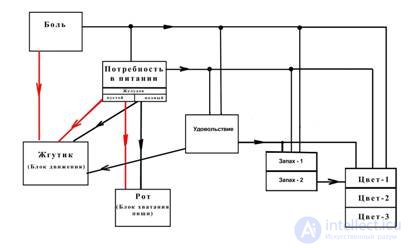
Fig. four
This scheme is a newborn beetle. It already has some connections between the blocks. Red lines indicate the excitatory connection between neurons, and black lines inhibitory. We describe the unconditioned reflexes that our bug has at birth. If the stomach is empty, the flagellum begins to move (a block of movement neurons is excited), the bug begins to search for food. The block of movements is not endowed with sensitive neurons, although in more complex models neurons of pain can be positioned on it, and the beetle will not feel the impact on the flagellum and will remain disabled. If the stomach is full, then the block of movement is blocked, why is it pointless to waste energy. When the Pain block is excited, the Movement block is activated, the bug should avoid pain, its main task is to live. On the Grabbing Food block, we place the neurons of pain and pleasure. If ingestible food gets into this block, the Movement block will be excited and the bug will try to escape from tasteless. When tasty food gets into the mouth, the neurons of pleasure will be excited and the block of Movement will be blocked. Bug will try to extend your enjoyment. Blocks of Smell and Colors are not connected, they are not associated with anything yet. The beetle has no organs of swallowing, the food immediately goes into the stomach.
Let us model the environment for the beetle and see how the connections between the blocks of neurons will be established as they learn about the world around them. Let us have 6 types of food. The food that will have a smell –1 will always be tasty regardless of color, and with a smell - 2 depending on the color, that tasty is not.
Smell-1, Color-1 - tasty food (З1-Ц1).
Smell-1, Color-2 - tasty food (З1-Ц2).
Smell-1, Color-3 - tasty food (З1-Ц3).
Smell-2, Color-1 - tasteless food (З2-Ц1).
Smell-2, Color-2 - delicious food (P2-C2).
Smell-2, Color-3 - tasteless food (P2-C3).
Release the beetle. What's happening? The stomach is empty, he begins to work flagella. The mouth makes grasping movements constantly. The beetle is a baby, everything drags in his mouth. The mouth is activated by motor neurons that are not involved in thinking. We give him food Z1-C1. The Scent-1 block is excited, as soon as the neurons of this block begin to recover after excitation, the neurons of the Color-1 block will be excited. At this time, the mouth is triggered, food enters the stomach, where the receptors of the Pleasure and Pain unit are located. At the beetle, neurons of pleasure are excited, as a result the flagellum is blocked, the stomach is filled and the beetle becomes full. Consider in fig. 5 connection, resulting from the first knowledge of the world.
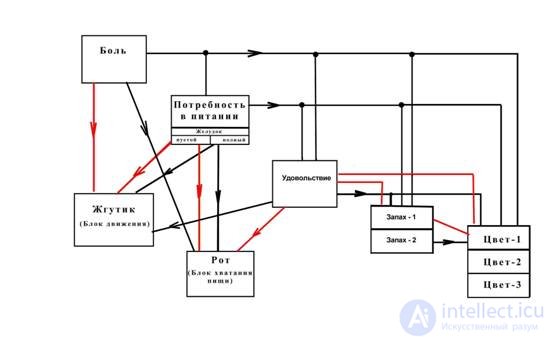
Fig. five
As a result of the first cognition, the following blocks were excited: Scent-1, Color-1, and Pleasure block. Accordingly, relations were established between them, somewhere weak, somewhere stronger, it does not matter. What happens to the beetle the next time he meets the same food a second time. The beetle will excite the Scent-1 block, which will excite either the Color-1 block or the Pleasure block. Among these two blocks, there will be a rivalry in the “ladder of priorities with reverse locking” scheme, the victory will depend on which connections have been established and how strongly the Color-1 beetle is affected. But even if the Color-1 block is excited by the next, the Pleasure block is activated next, even before food gets into it. Here she is a memory! The beetle felt a taste of pleasure without trying food.
We give the bug now tasteless food Z2-C1. While the beetle is full, it will not show signs of movement, so you need to wait until its stomach is free. Suppose the stomach is free, give Z2-C1. Block Scent-2 is excited, then color-1. The Color-1 block is associated with the Pleasure block, which speeds up the process of opening the mouth. This is already thinking, if the first food Color-1 and it is tasty, then the other food with the same color should have the same taste.
The beetle grabs food and then feels that it is tasteless. He is excited by the Block of Pain, which activates the block of Movement, the mouth is blocked, and the beetle moves away from food. New connections are presented in Figure 6.
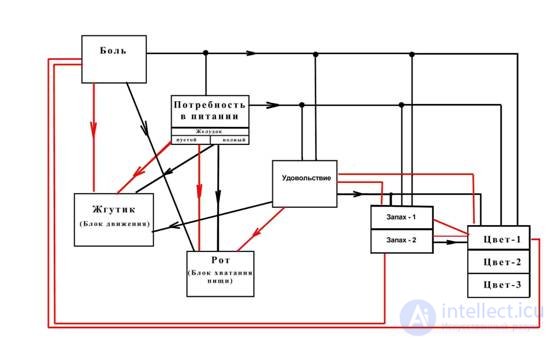
Pic.6
We should not forget that in everyday life, when, for example, we see a table, then at the beginning we can see a table leg, and only then it is entirely. It all depends on the shape of the lens of the eye at this moment and the distance of the table. Так и здесь, приоритет у запаха выше, чем у цвета, но блок цвета может возбудиться раньше, т.к. допустим, цвет распознается с более дальнего расстояния, чем запах.
Что произойдет с нашим жуком, если он в следующий встретит пищу З1-Ц1 или З2-Ц1? Пусть он вначале увидел Цвет-1, этот блок связан с болью и удовольствием, поэтому жучок, скорее всего, убежит, так как приоритет боли выше. Но многое зависит от количества и веса связей. Рассмотрим второй вариант: жук почуял Запах-1. Блок Запаха-1 начнет возбуждать блок Удовольствия и блок Цвет-1. Блок цвет-1 начнет возбуждать блок Боли и блок Удовольствия. В блоке Удовольствия будет возбуждено намного больше нейронов, чем в блоке Боли, поэтому исходя из лестницы приоритетов с обратной блокировкой, он заблокирует блок Боли и у жука активируется рот. Жучок теперь знает, что З1-Ц1 это «вкуснятина», а З2-Ц1 лучше не трогать. Он это понял с первого раза.
Дальнейшее обучение жука можно не объяснять, оно аналогично, а сразу перейти к окончательной схеме рис. 7
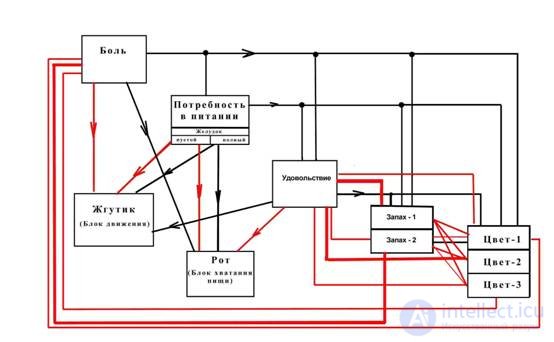
Fig. 7
Thicker red lines indicate a stronger connection arising from repeated repetition of any training.
Посмотрим, чему же научился наш жучок. Будем давать ему уже испробованную им пищу. Даем З1-Ц1, смотрим на рис.7: у этих блоков связей с блоком Удовольствия намного больше, чем с блоком Боли. Исходя из лестницы приоритетов с обратной блокировкой, блок Удовольствия заблокирует блок Боли, жучок почувствует удовольствие и постарается съесть пищу. Даем З1-Ц2: здесь только связи с блоком Удовольствия, следовательно, у жука даже при полном желудке может заработать блок Хватания пищи. Даем З1-Ц3: связей с блоком Удовольствия больше, блок Захвата пищи может заработать. Даем З2-Ц1: связей с блоком Боли намного больше, жук работает жгутиком и отходит. Даем З2-Ц2: связей с блоком Удовольствия больше, может активироваться блок Захвата пищи. Даем З2-Ц3: связей с блоком Боли больше, жук уходит от пищи. Обучение жука прошло успешно, он распознает все с первого раза.
Для лучшего распознавания предметов нужно использовать более большое количество блоков. Добавлять больше запахов, тактильные ощущения и т.п. При малом количестве блоков может возникнуть ситуация, что при сильном ощущении боли, какой либо блок всегда будет возбуждать боль, что будет мешать адекватному представлению об окружающем мире. Это очень примитивная модель, она описывает только основы мышления.
Предвозбуждение, дедукция и индукция, умозаключение.
Для более ясного понимания того, как реализуется индукция и дедукция при помощи нейронов, создадим небольшую схему. Возьмем для нее следующие группа нейронов: две группы нейронов реагирующих на свет (синий и красный), две группы нейронов осязания, две группы нейронов обоняния, четыре группы нейронов звука, две группы нейронов реагирующих на сладкое. Добавим сюда Желудок и блок Действия. Расставим в схеме безусловные рефлексы, пусть пустой Желудок и блок Сладкого возбуждает блок Действия (хватание пищи). Все это изобразим на рис.8
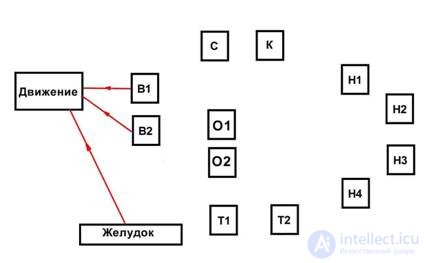
Fig. eight
Начнем обучать схему. Для этого возьмем два виртуальных объекта. Первый будет иметь три стороны и при попадании в Желудок возбуждать блоки Сладкого. Первая его сторона будет в схеме возбуждать блок цвета синего «С» вторая блок Осязания «О1», третья блок Обоняния «Т1». После поднесения к схеме, какой либо стороной виртуального предмета будем последовательно возбуждать два блока нейронов звука H1,H2. А после возбуждения блока Синего позволим схеме захватить пищу и этим самым установить связь между блоком Синего и Сладкого. Второй объект пусть также имеет три стороны. Первая его сторона возбуждает блок Синего «С», вторая блок Осязания O2, третья Обоняния «Т2» После поднесения второго объекта какой либо стороной, будем возбуждать блок нейронов Звука H3,H4. Обученная схема представлена на Рис.9.
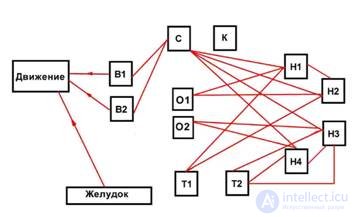
Fig. 9
Посмотрим где в схеме индукция. Блок H3,H4 можно возбудить тремя способами: возбуждая блок Синего «С», возбуждая блок Осязания «О2» или блок «Т2». Это и есть индукция, от частного к общему. Блок H3,H4 являются общими для блоков «С», «О2», «Т2».
Переходим к дедукции. Возбудим блок H3,H4, они связаны с блоками «С», «О2», «Т2». Блоки «С», «О2», «Т2» перейдут в предвозбужденное состояния. Но не дадим ни одному из них возбудиться, возбудив блок нейронов H1,H2. Блоки нейронов «С», «О1», «Т1» также перешли в предвозбужденное состояние. Но так как блок Синего «С» связан и с H1,H2 и с H3,H4, то следующим возбудиться он. Этот блок связан с блоками Сладкого. А блоки Сладкого с блоком Движения (безусловный рефлекс). Схема попытается схватить пищу, даже если в желудке есть пища. Общий блок Н1,Н2 возбудит блок Синего «С». Вот она и дедукция! Если в схеме позволить соединяться блокам Звука с блоками Сладкого, то возникнет ситуация, что блок H1,Н2 или блок Н3,Н4 будут возбуждать блок Сладкого, хотя непосредственно этому схему не обучали. Схема к такому заключению пришла самостоятельно. Не умозаключение ли это?
Рассмотрим умозаключение более подробно. Согласно дисциплине логике, умозаключением называется такой прием мышления, посредством которого мы из некоторого исходного знания получаем, выводное знание. Другими словами, если А=В, В=С то следовательно А=С. Реализуем это при помощи нейронов. Создадим небольшую схему. Она будет состоять всего из четырех блоков: двух блоков Осязания (О1, О2), одного блока Желтого цвета (Ж), одного блока Звука Н1. Блок Н1 соединим с блоком О1 и блоком Ж. Блоки О1 и О2 соединим с блоком Ж. Соединения О1-Ж и О2-Ж растянем во времени, для того чтобы блоки О1 и О2 не соединились между собой. Изобразим полученные соединения на рис. ten.
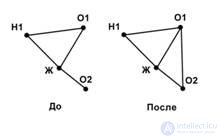
Fig. ten
Возбуждаем блок Н1, блоки Ж и О1 переходят в предвозбужденное состояние. Следующим шагом возбуждаем блок О2, он возбуждает предвозбужденный блок Ж который возбуждает предвозбужденный блок О1. В результате блоки О1 и О2 соединятся. То есть если О1=Ж, Ж=О2, то О2=О1. Как в реальной жизни, одна мысль сменила другую, но оказала воздействие на последующею мысль. Мысли не существуют сами по себе, они связаны друг с другом.
Схема использования одних и тех же групп нейронов в разных понятиях. Оптимизация использования нейронов.
В речи человека много слов, но все эти слова создают из определенных звуков. Из комбинаций этих звуков создаются слова из слов предложения. В разных языках звуки классифицируются по своему, в русском языке они разделены на 33 буквы, в английском на 26, в других на другое количество букв. Но в любом языке количество букв и соответствующих им звуков намного меньше, чем слов. Прекрасная оптимизация! Ниже будет приведена модель, при помощи которой будет сделана попытка объяснить как при помощи нейронов и их связей можно достичь подобной оптимизации. Возьмем для нашей модели следующие блоки: восемь блоков реагирующих на звук (пусть это будут звуки соответствующие буквам к, р, о, т, а, б, л, п), два блока реагирующих на свет (желтый, синий), и три блока запаха (h1,h2,h3). Высший приоритет дадим блокам звука, следующий цвету, низший запаху. Обучим модель трем словам: крот, краб, клоп. В словах «крот» и «краб» одинаковая последовательность части букв – кр, а в словах «крот» и «клоп» одинаковые буквы «к» и «о». Это и лежит в основе оптимизации. Пусть слову «крот» соответствует возбуждение групп нейронов Синего и Запаха h1 (понятие-1), слову «краб» блок Синего и Запаха h2 (понятие-2), слову «клоп» блок Желтого и Звука h3 (понятие-3). Обучим схему и представим ее на рис.11.
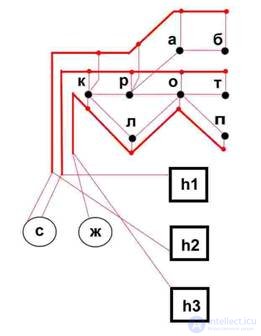
Рис.11
Давайте теперь посмотрим поведение схемы при воздействии на не? словами, без подкрепления воздействия светом и запахом. Произносим слово «крот». Первым возбуждается блок, отвечающий за букву «К». Следующим мог бы возбудиться блок Синего, но не успеет, блок буквы «Р» ему не даст. Дальше аналогично. Посмотрим суммирующие связи всего слова «крот», блок Синего предвозбуждался 6 раз, Желтый 2 раза, h1 – 4, с h2 – 2, с h3–2. Следовательно, возбудиться блок Синего, а за ним блок h1(понятие-1). Берем следующее слово «краб». Смотрим суммирующие связи слова «краб», Синий – 6, Желтый – 1, h1 – 2, h2 – 4, h3–2. Возбудятся блоки Синего и h2 (понятие-2),. Переходим к последнему слову «клоп», его суммирующие связи, Синий – 2, Желтый – 4, h1 – 2, h2 – 1, h3–4. Возбуждаются блоки Желтого и h3 (понятие-3). Достигнут требуемый результат. Схема обучилась.
Работа данной схемы рассматривалась без критических ситуаций. При сильном воздействии на какой либо блок, ее очень легко сделать «глупой». Допустим, блок буквы «к» сильно соединить с блоками Желтого и h3. Тогда при произношении любого слова схема будет давать один и тот же ответ. Реальные живые организмы защищены от этого большим количеством разнообразных блоков, но эта защита все равно не стопроцентная. Также при большом количестве похожих воздействий схема начнет путаться и стараться выдать один и тот же ответ. Возможно, это и лежит в основе ослабления интеллектуальных способностей с возрастом.
Заключение.
Эта модель не претендует на полную аналогию работы реальной нервной системы, хотя строилась из данных известных на сегодняшний день о ней. Возможно, в реальной нервной системе применены другие приемы организации нейронов, но основные принципы мышления скорее всего те же.
Перечислим основные принципы мышления, согласно предложенной модели искусственного интеллекта:
Чувствительные нейроны определяют сознание;
После возбуждения нейроны соединяются;
Нейроны подразделяются на группы с определенным приоритетом;
Одни и те же группы нейронов могут лежать в основе многих понятий.
Источник: http://neural.narod.ru/mod.html
Literature:
1. Урываев Ю. В., Рылов А.Л. Проникая в тайны мозга. М.: Сов. Россия, 1986
2. «Логика» Под редакцией Д.П. Горского и П.В. Таванца
Comments
To leave a comment
Natural Language Modeling of Thought Processes and Character Modeling
Terms: Natural Language Modeling of Thought Processes and Character Modeling